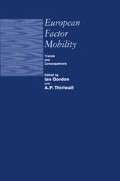Abstract
In the first thirty years after the last war, the European economies enjoyed an unparalleled experience of economic growth. Even in the period from 1960 to 1974 after post-war reconstruction was well past, real GDP managed to grow by 90 per cent, and industrial activity by 103 per cent. This experience of rapid growth was shared by virtually all of the countries involved, the only important exception being the UK. In a statistical sense at least, this growth is largely to be accounted for in terms of a sustained improvement in labour productivity, but an essential factor in all the countries involved was a substantial growth in non-agricultural employment (Kindleberger, 1967). Adequate labour supply to meet the growing needs of European companies was secured by tapping four principal sources of labour reserves (Castles, 1984). Two of these were indigenous involving, on the one hand, the transfer into urban employment of rural labour surpluses, and, on the other, the mobilisation for paid employment of substantial numbers of women previously active only in the domestic economy. The third source to be exploited, particularly as domestic sources of male labour neared exhaustion, took the form of international migration of workers, starting with those displaced from Eastern Europe — who added 11 million to the West German population between 1939 and 1954 — but dominated from the early 1960s by flows from the peasant agricultural economies of southern Europe and the sometime colonies of European powers.
Access this chapter
Tax calculation will be finalised at checkout
Purchases are for personal use only
Preview
Unable to display preview. Download preview PDF.
References
Böhning, W. R. (1984) Studies in International Labour Migration (London: Macmillan).
Burridge, P. and Gordon, I. R. (1981) ‘Unemployment in the British Metropolitan Labour Areas’, Oxford Economic Papers, 33, pp. 274–97.
Castles, S. (1984) Here for Good: Western Europe’s New Ethnic Minorities (London: Pluto Press).
Ethier, W. J. (1985) ‘International Trade and Labor Migration’, American Economic Review, 65, pp. 691–707.
Fröbel, F., Heinrichs, J. and Kreye, O. (1980) The New International Division of Labour (Cambridge: Cambridge University Press).
Gordon, I. R. (1985) ‘The Cyclical Interaction Between Regional Migration, Employment and Unemployment: A Time Series Analysis for Scotland’, Scottish Journal of Political Economy, 32, pp. 135–58.
Gordon, I. R. and Molho, I. I. (1985) ‘Women in the Labour Markets of the London Region: A Model of Dependence and Constraint’, Urban Studies, 22, pp. 367–86.
Gordon, I. R. and Vickerman, R. W. (1982) ‘Opportunity, Preference and Constraint: An Approach to the Analysis of Metropolitan Migration’, Urban Studies, 19, pp. 247–61.
Hammar, T. (ed.) (1985) European Immigration Policy: A Comparative Perspective (Cambridge: Cambridge University Press).
Harris, J. R. and Todaro, M. (1970) ‘Migration, Unemployment and Development: A Two Sector Analysis’, American Economic Review, 60, pp. 139–49.
Hicks, J. R. (1932) The Theory of Wages (London: Macmillan).
Jenkins, J. C. (1978) ‘The Demand for Immigrant Workers: Labor Scarcity or Social Control?’, International Migration Review, 12, pp. 514–35.
Jones K. and Smith, A. D. (1970) The Economic Impact of Commonwealth Immigration (Cambridge: Cambridge University Press).
Kaldor, N. (1966) Causes of the Slow Rate of Growth of the United Kingdom (Cambridge: Cambridge University Press).
Kindleberger, C. P. (1967) Europe’s Postwar Growth: The Role of Labour Supply (Oxford: Oxford University Press).
Kritz, M. M., Keely, C. B. and Tomasi, S. M. (eds) (1983) Global Trends in Migration: Theory and Research on International Population Movements (New York: Centre for Migration Studies).
Layard, R., Metcalf, D. and O’Brien, R. (1986) ‘A New Deal for the Long-term Unemployed’, in P. E. Hart (ed.), Unemployment and Labour Market Policies (London: Gower).
Long, J. F. (1981) Population Deconcentration in the United States (Washington, DC: US Bureau of the Census).
O’Loughlin, J. (1986) ‘Immigration to Western Europe, 1952–1982: A Time-series Analysis of Movement to Sweden, France, and Essen’, Environment and Planning A, 18, pp. 375–99.
Piore, M. J. (1979) Birds of Passage: Migrant Labour and Industrial Societies (Cambridge: Cambridge University Press).
Portes, A. (1983) ‘Modes of Structural Incorporation and Present Theories of Labour Immigration’, in Kritz AA et al., Global Trends in Migration.
Salt, J. (1989) ‘Labour Migration and Housing in the UK: An Overview’, in C. Hamnett and J. Allen (eds), Housing and Labour Markets (London: Hutchinson).
Shaw, R. P. (1985) Intermetropolitan Migration in Canada: Changing Determinants over Three Decades (Toronto: N.C. Press).
Sjaastad, L. A. (1962) ‘The Costs and Returns of Human Migration’, Journal of Political Economy, 7, pp. 80–93.
SOPEMI (annual) Continuous Reporting System on Migration (Paris: Directorate for Social Affairs, Manpower and Education, OECD).
Thomas, B. (ed.) (1958) Economics of International Migration (London: Macmillan).
Vanderkamp, J. (1971) ‘Migration Flows, Their Determinants and the Effects of Return Migration’, Journal of Political Economy, 79, pp. 1012–31.
Wood, C. H. (1982) ‘Equilibrium and Historical Structural Perspectives on Migration’, International Migration Review, 16, pp. 298–319.
Zolberg, A. (1983) ‘International Migrations in Political Perspective’, in Kritz AA et al., Global Trends in Migration.
Editor information
Editors and Affiliations
Copyright information
© 1989 Ian Gordon and A. P. Thirlwall
About this chapter
Cite this chapter
Gordon, I. (1989). The Role of International Migration in the Changing European Labour Market. In: Gordon, I., Thirlwall, A.P. (eds) European Factor Mobility. Confederation of European Economic Associations. Palgrave Macmillan, London. https://doi.org/10.1007/978-1-349-10044-6_2
Download citation
DOI: https://doi.org/10.1007/978-1-349-10044-6_2
Publisher Name: Palgrave Macmillan, London
Print ISBN: 978-1-349-10046-0
Online ISBN: 978-1-349-10044-6
eBook Packages: Palgrave Economics & Finance CollectionEconomics and Finance (R0)

